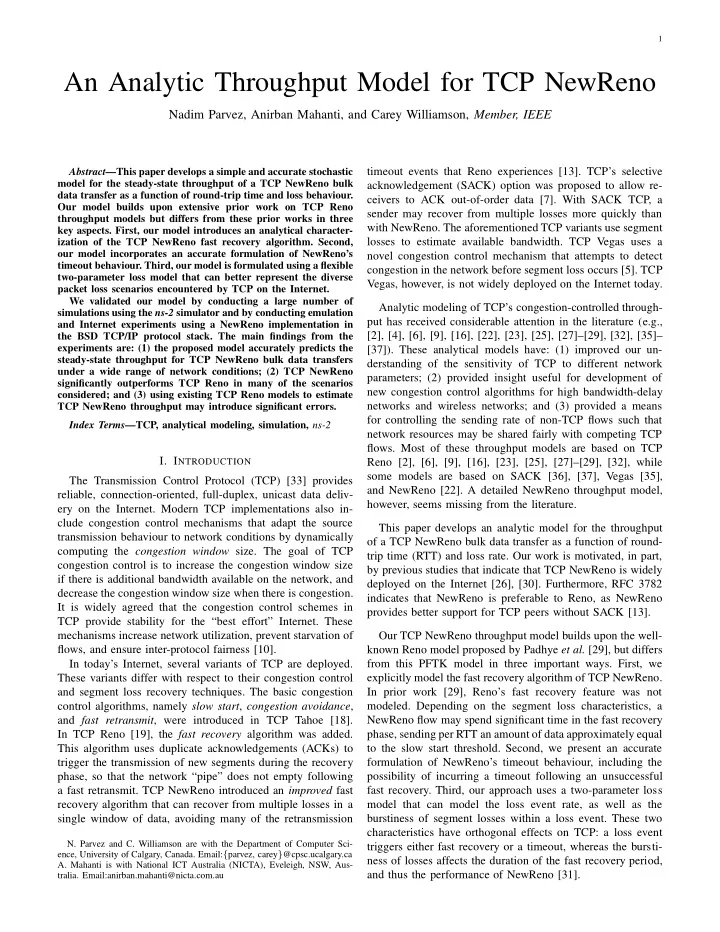

1 An Analytic Throughput Model for TCP NewReno Nadim Parvez, Anirban Mahanti, and Carey Williamson, Member, IEEE Abstract —This paper develops a simple and accurate stochastic timeout events that Reno experiences [13]. TCP’s selective model for the steady-state throughput of a TCP NewReno bulk acknowledgement (SACK) option was proposed to allow re- data transfer as a function of round-trip time and loss behaviour. ceivers to ACK out-of-order data [7]. With SACK TCP, a Our model builds upon extensive prior work on TCP Reno sender may recover from multiple losses more quickly than throughput models but differs from these prior works in three with NewReno. The aforementioned TCP variants use segment key aspects. First, our model introduces an analytical character- losses to estimate available bandwidth. TCP Vegas uses a ization of the TCP NewReno fast recovery algorithm. Second, our model incorporates an accurate formulation of NewReno’s novel congestion control mechanism that attempts to detect timeout behaviour. Third, our model is formulated using a flexible congestion in the network before segment loss occurs [5]. TCP two-parameter loss model that can better represent the diverse Vegas, however, is not widely deployed on the Internet today. packet loss scenarios encountered by TCP on the Internet. We validated our model by conducting a large number of Analytic modeling of TCP’s congestion-controlled through- simulations using the ns-2 simulator and by conducting emulation put has received considerable attention in the literature (e.g., and Internet experiments using a NewReno implementation in [2], [4], [6], [9], [16], [22], [23], [25], [27]–[29], [32], [35]– the BSD TCP/IP protocol stack. The main findings from the experiments are: (1) the proposed model accurately predicts the [37]). These analytical models have: (1) improved our un- steady-state throughput for TCP NewReno bulk data transfers derstanding of the sensitivity of TCP to different network under a wide range of network conditions; (2) TCP NewReno parameters; (2) provided insight useful for development of significantly outperforms TCP Reno in many of the scenarios new congestion control algorithms for high bandwidth-delay considered; and (3) using existing TCP Reno models to estimate networks and wireless networks; and (3) provided a means TCP NewReno throughput may introduce significant errors. for controlling the sending rate of non-TCP flows such that Index Terms —TCP, analytical modeling, simulation, ns-2 network resources may be shared fairly with competing TCP flows. Most of these throughput models are based on TCP I. I NTRODUCTION Reno [2], [6], [9], [16], [23], [25], [27]–[29], [32], while some models are based on SACK [36], [37], Vegas [35], The Transmission Control Protocol (TCP) [33] provides and NewReno [22]. A detailed NewReno throughput model, reliable, connection-oriented, full-duplex, unicast data deliv- however, seems missing from the literature. ery on the Internet. Modern TCP implementations also in- clude congestion control mechanisms that adapt the source This paper develops an analytic model for the throughput transmission behaviour to network conditions by dynamically of a TCP NewReno bulk data transfer as a function of round- computing the congestion window size. The goal of TCP trip time (RTT) and loss rate. Our work is motivated, in part, congestion control is to increase the congestion window size by previous studies that indicate that TCP NewReno is widely if there is additional bandwidth available on the network, and deployed on the Internet [26], [30]. Furthermore, RFC 3782 decrease the congestion window size when there is congestion. indicates that NewReno is preferable to Reno, as NewReno It is widely agreed that the congestion control schemes in provides better support for TCP peers without SACK [13]. TCP provide stability for the “best effort” Internet. These mechanisms increase network utilization, prevent starvation of Our TCP NewReno throughput model builds upon the well- flows, and ensure inter-protocol fairness [10]. known Reno model proposed by Padhye et al. [29], but differs In today’s Internet, several variants of TCP are deployed. from this PFTK model in three important ways. First, we These variants differ with respect to their congestion control explicitly model the fast recovery algorithm of TCP NewReno. and segment loss recovery techniques. The basic congestion In prior work [29], Reno’s fast recovery feature was not control algorithms, namely slow start , congestion avoidance , modeled. Depending on the segment loss characteristics, a and fast retransmit , were introduced in TCP Tahoe [18]. NewReno flow may spend significant time in the fast recovery In TCP Reno [19], the fast recovery algorithm was added. phase, sending per RTT an amount of data approximately equal This algorithm uses duplicate acknowledgements (ACKs) to to the slow start threshold. Second, we present an accurate trigger the transmission of new segments during the recovery formulation of NewReno’s timeout behaviour, including the phase, so that the network “pipe” does not empty following possibility of incurring a timeout following an unsuccessful fast recovery. Third, our approach uses a two-parameter loss a fast retransmit. TCP NewReno introduced an improved fast model that can model the loss event rate, as well as the recovery algorithm that can recover from multiple losses in a burstiness of segment losses within a loss event. These two single window of data, avoiding many of the retransmission characteristics have orthogonal effects on TCP: a loss event N. Parvez and C. Williamson are with the Department of Computer Sci- triggers either fast recovery or a timeout, whereas the bursti- ence, University of Calgary, Canada. Email: { parvez, carey } @cpsc.ucalgary.ca ness of losses affects the duration of the fast recovery period, A. Mahanti is with National ICT Australia (NICTA), Eveleigh, NSW, Aus- and thus the performance of NewReno [31]. tralia. Email:anirban.mahanti@nicta.com.au
Recommend
More recommend